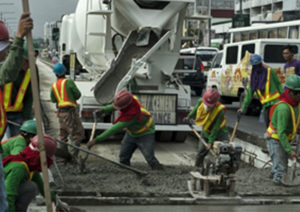
2Effects of Infrastructure Improvements to Property Values
Across the globe, infrastructure is the life-blood of prosperity and economic confidence in the 21st century. Well-planned and well-executed investments offer developing economies the hope of basic facilities for all and a chance to compete in a global marketplace. Emerging-market players are looking to remove transport bottlenecks and upgrade inadequate systems like what the Philippines is focusing today. The early enactment of the 2015 General Appropriations Act is set to power this year’s public spending courtesy of the National Government’s massive infrastructure programs scheduled for 2015.
Department of Budget and Management (DBM) Secretary Florencio “Butch” Abad said, “Last year’s underspending issue will be addressed by the increase in our infrastructure investments, which is equivalent to four percent of our projected GDP for this year. Ultimately, we’re targeting an infrastructure spending level of five percent by 2016.”
Eight PPP projects have been awarded so far by the Aquino government since the late-2010 launch of this flagship infrastructure program, namely: the P64.9-billion Light Rail Transit Line 1 (LRT-1) Cavite Extension; the P1.72-billion Automatic Fare Collection System; the P17.52-billion Mactan-Cebu International Airport Passenger Terminal Building; the P2.01-billion Daang Hari-South Luzon Expressway Link Road; the P15.52-billion Ninoy Aquino International Airport Expressway; the P16.28-billion first phase of the PPP for School Infrastructure Project (PSIP); the PSIP’s P3.86-billion second phase; and the P5.69-billion Philippine Orthopedic Center modernization.
Besides the Laguna Lakeshore Expressway Dike Project, six other PPP projects have been rolled out, namely: the P35.4-billion Cavite-Laguna Expressway; P2.50-billion Integrated Transport System (ITS) Project-Southwest Terminal; P4.50-billion ITS Project-South Terminal; P24.40-billion Bulacan Bulk Water Supply Project; P18.72-billion New Centennial Water Supply Source-Kaliwa Dam Project; and O&M of LRT-2.
But what does it mean for the real estate industry?
Property value is dependent upon many characteristics associated with that property such as its physical characteristics, location, view, amenities and accessibility, and the plans for the estate.
Basic infrastructure is necessary for the adequate functioning of an economy. To consolidate urban structure and cost of providing urban structure, existing infrastructure is more effectively utilized in the built-up urban areas. The infrastructures include services such as sewerage and drains, roads, public transport as well as social infrastructures such as health care facilities, education facilities and other community services. These attributes are usually provided by the government.
The physical attributes and locational influences may be described as “the fundamental factors” of property value, in that all individuals receive utility or disutility from there influences over their entire expected tenure (Norman, 1982). Physical attributes may be described as building area, type of structure and so on. Locational influences pertain to off-site neighborhood attributes such as parks, health care facilities and so on.
Transportation improvements
These effects on real estate markets have been well-studied but are still not well understood. There have been numerous studies on the effects of transportation improvements on real estate values. Most analyze the effects of highway expansions or original construction on residential sale prices, with the goal of establishing the economic impacts of highway construction.
Gonzales-Navarro, Berkeley, Quintana- Domeque and d’Alacant (2010) designed a unique street-pavement experiment in Mexico, the first to solve the selection bias inherent in street-pavement placement by using random assignment, and estimated positive experimental effects on home values and residential investment. They documented that the provision of pavement reduced the distance to the nearest paved street for some of the properties in the control group. This treatment-spillover effect could then be measured by estimating the increase in home values due to the reduction in distance for the control group. It showed that residential property values were 3% higher per street block that was reduced in distance to the nearest paved street, indicating that the experimental effect from the treatment-control groups comparison was slightly downward biased. Correcting for the downward bias, they found out that housing values increased by 23-27%, according to homeowners, or by 16-17% according to a professional appraiser.
In his extensive literature review, Huang (1994) found that virtually, every major land use study came to the conclusion that transportation improvements positively affect the value of nearby land. While the estimates of those effects ranged from almost nonexistent to over a 10% increase in property values.
Major improvements to existing transportation infrastructure should also have a strong, positive effect on nearby real estate values. However, the impacts may be highly localized and of a much lesser degree than those caused by the original construction. According to the classical economic theory, when a highway is initially built, large parcels of land that previously had poor accessibility (or none at all) are suddenly underpriced. Land values may also fall elsewhere due to changes in relative access and certain land uses may be negatively impacted by the noise, emissions, and vibrations that close proximity to major roadways presents. Construction-associated impacts can also reduce values in the short term, while projects are underway: Down’s data (1992) suggested that values did reach pre-construction levels until approximately five years after roadway project completion.
Home prices rise in response to transportation improvements that occur along shortest path routes connecting individual homes to the region’s CBD or local shopping center, in general, however, prices fell as a response to nearby transportation-related construction. (Mikelbank, 2001)
But in the end, improvements in the urban transport system are typically associated with large benefits. As an example, a new transit line can reduce travel times between various pairs of locations and free up commuting time for which there is better use – be it for work or leisure. Moreover, the additional capacities may reduce congestion and increase the comfort of journeys not only along new sections, but also along the entire network.
Obviously, the areas close to new infrastructure benefit the most. There is plenty of evidence that the opening of new metro rail stations significantly increases property prices in the adjoining neighborhood. This is because buyers value the infrastructure and, all else being equal, are willing to pay higher prices. Owners of properties that receive a better connection to a transport network, thus, not only benefit from improved access to transport services, but also from an increase in the value of their typically largest asset: their property.
Improvement in transportation infrastructure had bought positive effects in property values. The Philippines should continue to allocate resources and invest more in the transport infrastructure to improve the accessibility of the new development area to improve the quality of living and create more development opportunity to sustain the Philippine’s future development.
References
Berkeley, U., d’Alacant, U., Gonzalez-Navarro, M., Quintana-Domeque, C. (2010). Public Infrastructure, Private Investment and Residential Property Values: Experimental Evidence from Street Pavement. Retrieved from http://www.rand.org/content/dam/rand/www/external/labor/seminars/adp/pdfs/2010/gonzalez-navarro.pdf
Downs, A. (1992). Stuck in Traffic.
Huang, W. (1994). The Effects of Transportation Infrastructure on Nearby Property Values: A Review of the Literature.
Mikelbank, B. (2001). Spacial Analysis of the Relationship between Housing Values and Investments in Transportation Infrastructure
Norman, G.M. (1982). Residential Property Hedonic Pricing Models












